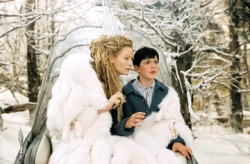The Chronicles of Narnia: The Lion, the Witch, and the Wardrobe
 One of the assumptions of the narrative arts is that often the content will require audience generosity, in the sense that we will forgive an outlandish premise, necessary exposition, overly colorful characters, or tidy, upbeat outcomes because novels, theater, and films are not real life. It’s called the “suspension of disbelief,” and it’s fundamental to any pleasure drawn from art; we must give ourselves over to the work, and invest ourselves in it, to get anything back from it. We accept the idea of Spider-Man because it’s required to enjoy the comic books and movies featuring the character.
One of the assumptions of the narrative arts is that often the content will require audience generosity, in the sense that we will forgive an outlandish premise, necessary exposition, overly colorful characters, or tidy, upbeat outcomes because novels, theater, and films are not real life. It’s called the “suspension of disbelief,” and it’s fundamental to any pleasure drawn from art; we must give ourselves over to the work, and invest ourselves in it, to get anything back from it. We accept the idea of Spider-Man because it’s required to enjoy the comic books and movies featuring the character.
But often the suspension of disbelief is an excuse. It works like this: If you don’t find a character or plot line credible, an apologist might tell you, “You’ve got to suspend your disbelief.” Your lack of enjoyment becomes your failure, not the work’s.
But the suspension of disbelief, to borrow a hackneyed maxim, is a privilege, not a right; you need to earn it. And last year’s holiday hit The Chronicles of Narnia: The Lion, the Witch, and the Wardrobe doesn’t.
I’m not even talking about the acting or numerous sore-thumb instances of deus ex machina; the movie’s shabby production design overwhelms all other complaints.
(Okay, I’ll say this about the resurrection of Aslan: By not laying the groundwork for the event, the movie underscores the ridiculousness of many miraculous sacred stories in terms of narrative logic; religions get the benefit of suspension of disbelief yet rarely deserve it. [And let’s not even talk about the appearance of fucking Santa Claus in the movie … .])
Co-written and directed by Andrew Adamson (co-director of Shrek and its sequel), this adaptation of the C.S. Lewis classic had a production budget of $180 million, but you’d never know from looking at it. Once the children leave their real-world surroundings, the movie is saddled with three distinct texture problems: Everything is lit as if it were shot on a sound stage; the performers always look like they’re acting in front of a green screen; and the computer-animated creatures all look hopelessly fake.
In these ways, Narnia is no worse than George Lucas’ Star Wars prequels and their myriad visual sins, except that The Lion, the Witch, and the Wardrobe takes place mostly outside, where artless lighting gives the impression of a stage production. So this magical land full of mythological creatures and substitutes for Christ and Satan never feels like more than a cheap construction, a half-assed effort. This is a movie whose look has no sense of filmmaking art or craft, and as a result, nothing else works, either.


OK, i agree. (Was Santa Claus in the book?!) But why is it relevant now? Is there a new Chronicle coming out this holiday season?
toddm,
Alas, timeliness and relevance are not qualities one should seek from Culture Snob. I get to things when I get to them. I have a day job, you know.
(Full disclosure: toddm is Culture Snob’s boss.)
Awesome review C.S. I was completely uninterested in seeing it before and I was willing to risk spoilers because I had a feeling I’d never see it anyways. It’s sad to hear that it seemed as thought they gave this production to the interns at Industrial Light and Magic…